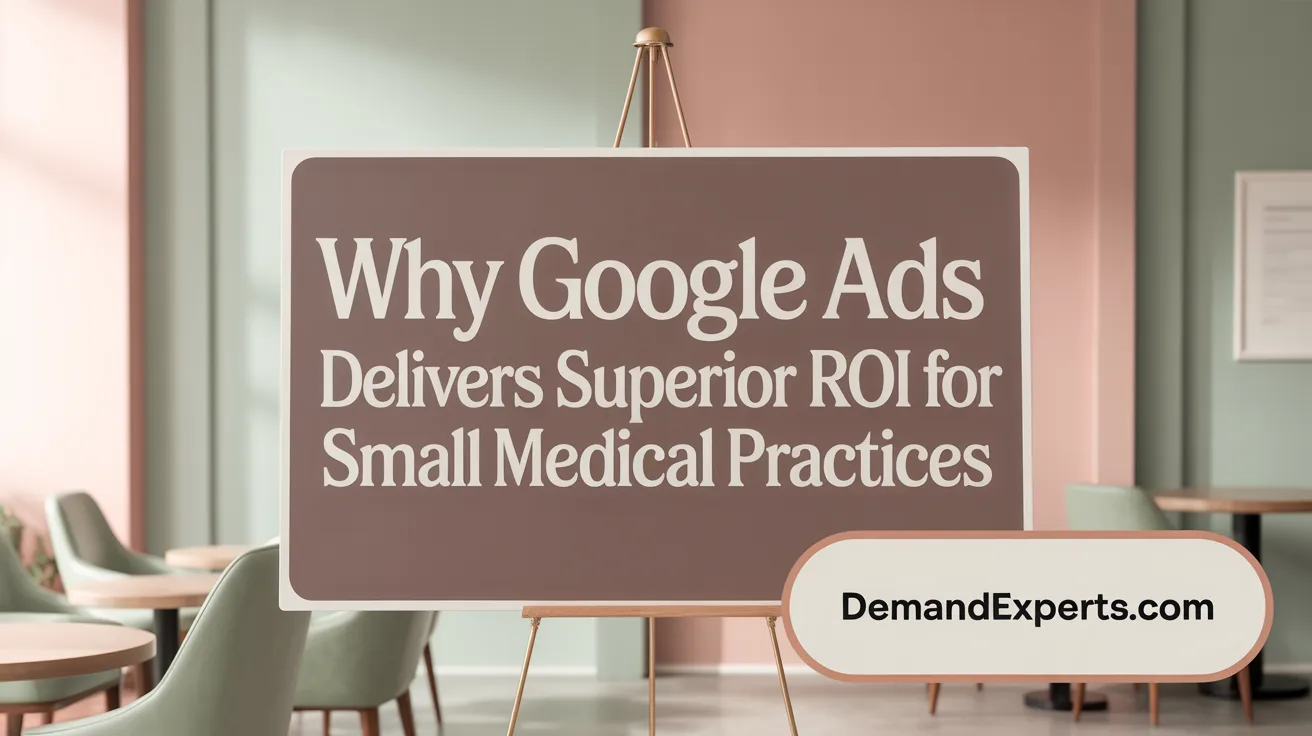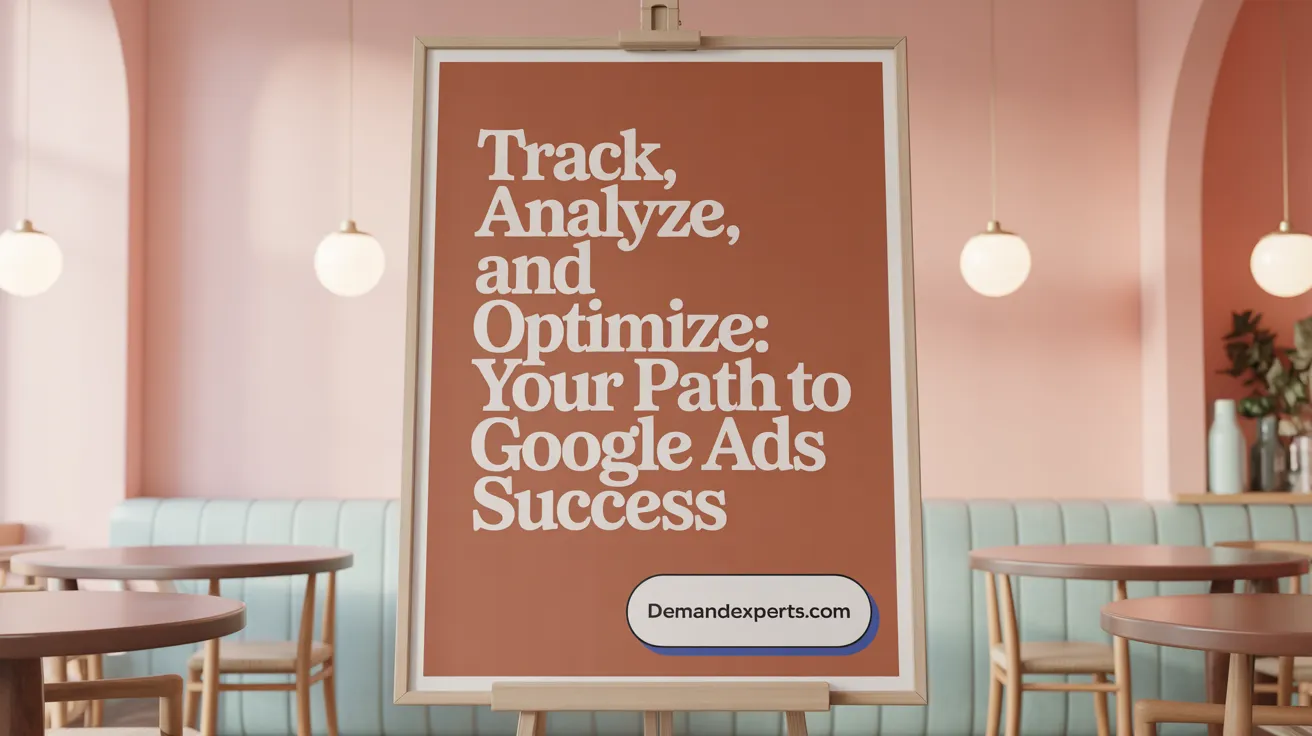Introduction to Smart Google Ads for Small Medical Practices
Small medical practices face unique challenges when it comes to marketing, balancing limited budgets against the need to attract new patients. Google Ads, with its pay-per-click model, offers a compelling solution to reach targeted local audiences efficiently. This article explores how small healthcare providers can manage Google Ads cost-effectively, optimize campaign performance, and ultimately grow their patient base with strategic digital advertising.
Understanding Google Ads for Medical Practices
Google Ads basics for healthcare
Google Ads is a valuable tool for medical practices to reach patients actively searching for healthcare services online. It uses a pay-per-click (PPC) model, meaning practices only pay when someone clicks on their ad, making it cost-effective, especially for smaller clinics. Google Ads helps practices appear at the top of search results, increasing their visibility immediately compared to organic search methods like SEO (Complementing SEO with Paid Advertising).
Types of Google Ads relevant for medical practices
Medical practices can choose from several Google Ads formats for medical services:
- Search Ads: Text-based ads that appear when users search for relevant health services (Search Campaigns for Healthcare, Search Ads in healthcare marketing).
- Display Ads: Visual banners shown on websites to raise brand awareness (Display Ads in healthcare marketing, Healthcare Display Ads CPC).
- YouTube Ads: Video ads that help engage patients through storytelling or education (YouTube Ads for doctors.
- Local Service Ads: Targeted for specific specialties like dental practices, helping attract local patients (Google Local Search Ads for Doctors, Local Service Ads benefits.
Each ad type serves different goals, from direct appointment bookings to building patient trust and recognition (Healthcare PPC advertising).
How Google Ads targeting works
Google Ads offers advanced targeting options in Google Ads to help medical practices reach the right audience effectively:
- Geographic targeting to reach patients in specific locations (Geographic Healthcare Targeting, Geo-targeting for Local Medical Practices).
- Demographic targeting such as age and gender (Using demographic data in Facebook Ads, Healthcare Demographic Targeting).
- Interest and behavior targeting to tailor ads based on user actions (Behavioral targeting in healthcare advertising, Behavioral Filters.
- Device targeting, ensuring ads look and perform well on mobile devices, critical since many health searches occur on phones (Mobile-optimized healthcare ad campaigns, Mobile Optimization for Healthcare Ads.
These targeting features ensure ads are shown to potential patients most likely to need and engage with healthcare services, optimizing budget use and maximizing ROI of Google Ads vs Social Media Ads.
Why Google Ads Outperform Other Advertising Channels for Small Practices

What makes Google Ads more effective than social media and other PPC platforms for medical practices?
Google Ads typically deliver a higher return on investment (ROI of Google Ads vs Social Media Ads for healthcare providers compared to social media ads and other pay-per-click (Google PPC Ads for Medical Practices platforms like Bing and Yahoo. This is largely because Google Ads target users actively searching for medical services, capturing high-intent audiences whose behavior indicates readiness to make appointments.
Search intent targeting sets Google Ads apart. When potential patients enter queries such as "pediatrician near me" or "urgent care clinic," Google Ads appear at the top of the results, immediately meeting the searcher's needs. Social media ads, while excellent for brand awareness and engagement (Facebook Ads for healthcare audience targeting, often target users who are not actively seeking healthcare, resulting in lower conversion rates.
Insights from PatientGain research on platform effectiveness
PatientGain's extensive testing over a decade reveals that Google Ads surpass Bing, Yahoo, and other search-based PPC platforms in ROI and targeting precision for medical practices. Their studies highlight Google's advanced demographic and geographic targeting options (Google Ads targeting options for doctors, which allow doctors to tailor ads by age, location, and interests, optimizing reach to local patient segments.
By focusing on precisely organized keyword groups and landing page optimization, Google Ads campaigns benefit from higher Quality Scores, reducing costs per click and improving ad placements. This strategic approach results in more cost-effective campaigns that yield better patient acquisition results.
How can journalists ensure their information is well-researched and factual?
Journalists can ensure accuracy by verifying sources' credibility and cross-checking facts through multiple reliable references. They should conduct detailed fact checks of statistics and quotes, provide proper citations, maintain objectivity, and include diverse perspectives. Following ethical standards, transparency, and promptly correcting any errors further uphold the information's trustworthiness and integrity (Claim your business online).
Cost Structure and Budgeting: Maximizing Value with Limited Resources
Typical Google Ads Costs for Small Practices
Google Ads offers a pay-per-click (PPC) pricing model, allowing medical practices to pay only when potential patients click their ads. This model is particularly cost-effective for small healthcare providers with limited budgets. Average cost per click (CPC) in healthcare advertising typically ranges between $2 and $4, depending on the specialty and location.
Monthly ad spends vary by type of practice. For example, primary care clinics may budget around $600 to $1,300 monthly, while urgent care centers often allocate between $1,000 and $7,000. Smaller practices frequently start with modest budgets in the $500–$1,000 range, scaling as results and ROI become clear.
Management Fees and What They Cover
Professional management of Google Ads campaigns is advised for optimal performance and regulatory compliance. Management fees generally run around 18% of the total ad spend. These fees cover essential services such as:
- Keyword research and selection
- Ad copywriting and testing
- Bid management and budget optimization
- Landing page review and optimization
- Negative keyword implementation
- Continuous monitoring and adjustment
Engaging experts ensures campaigns comply with healthcare regulations, including HIPAA, while maximizing ad relevance and quality scores to reduce costs.
Budgeting Methodologies and Starting Amounts
Effective budgeting often starts by calculating daily required clicks based on keyword CPCs (e.g., multiplying average CPC by 3-6 clicks daily). Multiplied by approximately 25 working days per month, this approach helps estimate a baseline monthly spend.
A typical starting budget for a general medical practice might begin at $1,000 per month, focusing on high-intent keywords and local targeting. Ongoing optimization and data-driven adjustments allow the practice to improve ROI and scale efficiently without overspending.
By combining modest starting budgets, professional management, and continual campaign refinement, small medical practices can achieve substantial patient acquisition at a reasonable cost.
Targeting Strategies Tailored for Small Medical Practices
Geographic and Demographic Targeting Options
Google Ads provides powerful geographic and demographic targeting tools that allow small medical practices to connect with local patients effectively. Practices can narrow ad delivery by location, focusing on city, zip code, or radius around their office to ensure ads reach nearby audiences. Demographic filters such as age, gender, and household income help refine patient targeting further, ensuring the ads resonate with the relevant groups for specific medical services.
Behavioral and Interest-Based Targeting
Beyond basic demographics, Google Ads enables targeting based on user behavior in healthcare ads. This includes tailoring campaigns to individuals who have searched for specific symptoms, treatments, or medical specialties. Behavioral targeting maximizes relevance by showing ads to users actively seeking healthcare solutions and who are more likely to convert. Incorporating interest-based filters also supports outreach to patient segments aligned with the practice's specialty or services.
Mobile Optimization and Click-to-Call Feature
Considering that a majority of healthcare-related searches happen on mobile devices, mobile optimization for medical ads is essential for small practices. Mobile-optimized ads and landing pages improve user experience, helping potential patients find and contact the practice easily. The inclusion of click-to-call ad extensions is particularly beneficial, enabling users to call the practice directly from search results with one tap, increasing appointment bookings and patient engagement.
By combining precise geographic, demographic, and behavioral targeting with mobile-friendly ad features, small medical practices can create highly effective Google Ads campaigns for healthcare businesses that efficiently attract local, relevant patients.
Creating High-Impact Ads and Landing Pages

Keyword research and grouping
Effective Google Ads campaigns start with thorough keyword research. Healthcare providers should focus on high-intent keywords such as specific services or urgent care queries that potential patients actively search for, like "dermatologist near me" or "pediatric dentist appointment".
Organizing these keywords into tightly themed groups improves ad relevance and Quality Scores, which reduces costs and increases ad placement efficiency. Grouping also enables tailored ad copy and landing pages for each theme, enhancing user experience and conversion rates.
Ad copywriting best practices
Ad copy must be clear, relevant, and patient-centric. Highlighting expertise, specific services, and including compelling calls-to-action motivates potential patients to click. Compliance with healthcare advertising regulations is crucial — avoiding misleading claims and ensuring transparency builds trust (Healthcare Advertising Compliance.
Regular A/B testing of headlines and descriptions helps identify the most effective messaging. Incorporating ad extensions like call buttons, site links, and location information further increases ad visibility and engagement.
Landing page optimization for conversions
Landing pages should seamlessly match the ad copy, ensuring consistent messaging. They must be mobile-optimized, fast-loading, and HIPAA-compliant to create a trustworthy and accessible experience.
Essential elements include clear calls-to-action, easy-to-use contact forms or click-to-call features, patient testimonials, and trust signals such as certifications or reviews (Landing page optimization for Google Ads.
Dedicated landing pages tailored to specific campaigns improve conversion likelihood by addressing patient needs directly and reducing friction from search intent to appointment booking (Optimizing Google Ads Performance).
Optimizing Campaign Performance Through Continuous Monitoring
What key performance indicators should healthcare practices track in Google Ads campaigns?
To optimize Google Ads Campaign Optimization effectively, healthcare providers should monitor several crucial metrics. The Clickthrough Rate improvements reveals how well an ad attracts clicks relative to impressions, indicating the ad’s relevance. Tracking conversions in healthcare ads measures how many clicks translate into desired actions such as appointment bookings. Google Ads Cost Per Conversion for Healthcare evaluates how much is spent per user interaction, and ROI of Google Ads vs Social Media Ads calculates the profitability of ad spend. Improving Google Ads Quality Score, accounting for ad and landing page relevance and CTR, affects costs and ad positioning. Regular tracking of these KPIs enables data-driven adjustments for better results.
How can A/B testing and bid adjustments enhance campaign effectiveness?
A/B testing different elements such as ad copy, headlines, and calls-to-action helps identify the most compelling versions to engage potential patients. Testing variations also aids in refining messages to better match patient needs. Bid adjustments based on device, location, time, and demographics allow more efficient budget allocation toward high-performing segments. Combining manual and automated bidding strategies can provide a balance of control and efficiency, helping maximize conversions while keeping costs in check.
What role do negative keywords and ad extensions play in Google Ads optimization?
Negative Keywords in Healthcare PPC filter out irrelevant or low-intent searches, preventing wasted ad spend and increasing ad relevance. For example, excluding unrelated terms ensures ads show only to users considering specific healthcare services. Ad extensions for medical practices like site links, call buttons, and location information enrich ads with extra details, improving user engagement and click-through rates. Extensions tailored to patient needs make ads more attractive and easier to interact with, directly contributing to increased appointment inquiries.
Continuous monitoring combined with these techniques ensures that healthcare Creating Google Ads Campaigns for Healthcare remain competitive, cost-effective, and aligned with patient acquisition goals.
Regulatory Compliance and Ethical Advertising in Healthcare
What are the HIPAA considerations in online ads?
Ensuring compliance with the Health Insurance Portability and Accountability Act (HIPAA) is fundamental for healthcare providers running Google Ads campaigns. Practices must protect patient privacy, avoiding the disclosure of personal health information in ad content or landing pages. Ads should feature information that is HIPAA-compliant, maintaining confidentiality while promoting services.
How can healthcare ads avoid misleading claims?
Ads must be transparent, honest, and free from unsubstantiated promises. Avoiding exaggerated or misleading claims about treatments ensures ethical advertising and builds patient trust. Accurate representation of services, clear calls to action, and compliance with Google’s healthcare advertising policies help maintain credibility.
What are key platform policies and privacy laws to follow?
Google and Facebook advertising platforms impose strict regulations to safeguard user privacy and sensitive healthcare information. Advertisers must comply with platform policies, prohibiting sensitive language, unauthorized use of personal health data, and misleading content. Adherence to local healthcare laws and digital advertising standards is essential to avoid penalties and protect patient rights.
Upholding these ethical and regulatory standards not only ensures legal compliance but also enhances patient confidence, which is vital for successful healthcare marketing campaigns.
Integrating Google Ads with SEO and Social Media Marketing

How Do SEO and Google Ads Complement Each Other in Healthcare Marketing?
SEO and Google Ads work hand-in-hand to boost a healthcare practice’s online presence. While SEO focuses on organic search results, improving long-term visibility by optimizing website content and structure, Google Ads delivers immediate visibility by placing your practice at the top of search results through paid campaigns. Using paid Google Ads alongside SEO strategies can increase patient leads and revenue more effectively than relying on one method alone. For more on the synergy between SEO and paid advertising, see Complementing SEO with Paid Advertising.
What Role Does Social Media Play in Patient Engagement?
Social media platforms like Facebook, Instagram, YouTube, and TikTok serve as crucial tools for educating, engaging, and building trust with patients. Unlike Google Ads that capture active search intent, social media facilitates community engagement and brand awareness through storytelling, patient testimonials, and educational content. These channels help practices maintain ongoing communication with patients, encourage positive reviews, and foster loyalty. Explore strategies for Healthcare Brand Awareness with Facebook Ads and YouTube for Healthcare Providers.
How Should Healthcare Practices Allocate Budgets Across Google Ads, SEO, and Social Media?
For a balanced digital marketing approach, healthcare practices often start with modest budgets for each channel—typically around $500 to $1,000 monthly per platform—adjusting based on performance. Google Ads offers direct patient acquisition with measurable ROI, SEO builds sustainable organic traffic, and social media strengthens patient relationships. Integrating all three ensures comprehensive coverage—from attracting new patients searching for services to keeping the community engaged and informed. For detailed insights, refer to Google Ads Budget Optimization Expert Tips and Healthcare PPC Advertising Budgeting.
This multi-channel strategy helps medical practices maximize their online impact, providing a consistent patient pipeline and a trustworthy brand presence. For additional expert guidance, visit Healthcare Marketing Strategies and Analytics.
Leveraging Professional Management Services for Efficient Google Ads

Benefits of expert campaign management
Managing Google PPC Ads for Medical Practices requires specialized skills to optimize every component from keyword targeting to ad copy and landing pages. Professionals bring expertise in organizing keywords into relevant groups, setting negative keywords, using ad extensions, and device targeting. They actively monitor campaigns, conducting A/B testing and bid adjustments to maintain high Quality Scores. This ensures ads appear prominently, lowering costs per click and increasing patient engagement. Experienced managers also handle compliance with healthcare advertising laws like HIPAA, preventing costly mistakes (Healthcare Google Ads Compliance.
Typical management fees and ROI implications
Healthcare practices generally pay around 18% of their monthly ad spend for professional Google Ads management services. This fee covers ongoing optimization, performance monitoring, and campaign refinement (PPC Management Fees for Healthcare. While it adds to the overall marketing budget, it contributes to a significantly higher return on investment (ROI) compared to unmanaged or poorly managed campaigns (ROI of Google Ads vs Social Media Ads. Expert management reduces budget waste by minimizing clicks from non-patients and competitors (Preventing Competitor Clicks on Ads, ensuring targeted patient acquisition for justifiable ad spend.
Use of agencies specializing in healthcare marketing
Many agencies specialize exclusively in healthcare digital marketing, offering tailored Google Ads management services (Healthcare marketing agency). These agencies understand the nuances of healthcare marketing, HIPAA compliance, and Google’s healthcare ad policies (Healthcare Advertising Compliance. They provide end-to-end solutions, including keyword research, ad creation, landing page optimization, and transparent reporting (Google Ads Campaign Optimization). By partnering with such agencies, medical practices benefit from data-driven marketing strategies that enhance visibility, improve appointment bookings, and grow patient bases efficiently while ensuring legal and ethical standards are met.
Measuring Success and Adjusting Campaign Strategies

Tracking Conversions and ROI
For medical practices using Google PPC Ads for Medical Practices, tracking conversions such as appointment bookings, phone calls, and form submissions is critical to evaluating the campaign's return on investment (ROI). Since Google Ads operates on a pay-per-click (PPC) model, understanding which clicks lead to meaningful patient engagements ensures your advertising budget is spent effectively.
Call and Form Tracking Importance
Call tracking is especially important because many patient conversions happen offline via phone calls. Using call tracking tools helps link these calls back to specific ads, allowing practices to understand which campaigns drive patient inquiries. Similarly, form tracking on landing pages captures leads from potential patients filling out contact forms. Together, these methods provide a comprehensive view of how ads translate into real patient interest. For more on Call Tracking and Attribution, and Tracking Campaign Metrics, these resources offer in-depth guidance.
Using Analytics to Refine Campaigns
Regularly analyzing key performance indicators (KPIs) such as click-through rate (CTR), cost per conversion, and quality score enables ongoing optimization. Analytics tools help identify which keywords, ads, or targeting settings are performing best. Healthcare providers can then adjust bids, test different ad copies through A/B testing, refine keyword lists, and optimize landing pages for better conversions. Continuous monitoring and data-driven adjustments ensure campaigns remain cost-effective and relevant to patient needs, ultimately maximizing ROI for small medical practices. For strategies on Optimizing Google Ads Campaigns, Improving Google Ads Quality Score, and Google Ads Optimizations to Maximize Your Healthcare Budget, these links provide actionable insights.
Conclusion: Strategic Investment in Google Ads for Small Practices
Small medical practices can significantly benefit from well-managed Google Ads campaigns that are cost-effective and precisely targeted. By understanding the platform’s nuances, employing strategic bidding and keyword optimization, and ensuring compliance with healthcare advertising regulations, small practices can maximize their advertising ROI. Integration with other marketing channels like SEO and social media further amplifies their online presence. Partnering with professional agencies that specialize in healthcare marketing enhances campaign effectiveness, enabling healthcare providers to focus on patient care while growing their practice sustainably. In an increasingly digital world, leveraging Google Ads smartly is an essential tool for small practices aiming to expand their patient base without exceeding budget constraints.
Introduction to Smart Google Ads for Small Medical Practices
Small medical practices face unique challenges when it comes to marketing, balancing limited budgets against the need to attract new patients. Google Ads, with its pay-per-click model, offers a compelling solution to reach targeted local audiences efficiently. This article explores how small healthcare providers can manage Google Ads cost-effectively, optimize campaign performance, and ultimately grow their patient base with strategic digital advertising.
Understanding Google Ads for Medical Practices
Google Ads basics for healthcare
Google Ads is a valuable tool for medical practices to reach patients actively searching for healthcare services online. It uses a pay-per-click (PPC) model, meaning practices only pay when someone clicks on their ad, making it cost-effective, especially for smaller clinics. Google Ads helps practices appear at the top of search results, increasing their visibility immediately compared to organic search methods like SEO (Complementing SEO with Paid Advertising).
Types of Google Ads relevant for medical practices
Medical practices can choose from several Google Ads formats for medical services:
- Search Ads: Text-based ads that appear when users search for relevant health services (Search Campaigns for Healthcare, Search Ads in healthcare marketing).
- Display Ads: Visual banners shown on websites to raise brand awareness (Display Ads in healthcare marketing, Healthcare Display Ads CPC).
- YouTube Ads: Video ads that help engage patients through storytelling or education (YouTube Ads for doctors.
- Local Service Ads: Targeted for specific specialties like dental practices, helping attract local patients (Google Local Search Ads for Doctors, Local Service Ads benefits.
Each ad type serves different goals, from direct appointment bookings to building patient trust and recognition (Healthcare PPC advertising).
How Google Ads targeting works
Google Ads offers advanced targeting options in Google Ads to help medical practices reach the right audience effectively:
- Geographic targeting to reach patients in specific locations (Geographic Healthcare Targeting, Geo-targeting for Local Medical Practices).
- Demographic targeting such as age and gender (Using demographic data in Facebook Ads, Healthcare Demographic Targeting).
- Interest and behavior targeting to tailor ads based on user actions (Behavioral targeting in healthcare advertising, Behavioral Filters.
- Device targeting, ensuring ads look and perform well on mobile devices, critical since many health searches occur on phones (Mobile-optimized healthcare ad campaigns, Mobile Optimization for Healthcare Ads.
These targeting features ensure ads are shown to potential patients most likely to need and engage with healthcare services, optimizing budget use and maximizing ROI of Google Ads vs Social Media Ads.
Why Google Ads Outperform Other Advertising Channels for Small Practices

What makes Google Ads more effective than social media and other PPC platforms for medical practices?
Google Ads typically deliver a higher return on investment (ROI of Google Ads vs Social Media Ads for healthcare providers compared to social media ads and other pay-per-click (Google PPC Ads for Medical Practices platforms like Bing and Yahoo. This is largely because Google Ads target users actively searching for medical services, capturing high-intent audiences whose behavior indicates readiness to make appointments.
Search intent targeting sets Google Ads apart. When potential patients enter queries such as "pediatrician near me" or "urgent care clinic," Google Ads appear at the top of the results, immediately meeting the searcher's needs. Social media ads, while excellent for brand awareness and engagement (Facebook Ads for healthcare audience targeting, often target users who are not actively seeking healthcare, resulting in lower conversion rates.
Insights from PatientGain research on platform effectiveness
PatientGain's extensive testing over a decade reveals that Google Ads surpass Bing, Yahoo, and other search-based PPC platforms in ROI and targeting precision for medical practices. Their studies highlight Google's advanced demographic and geographic targeting options (Google Ads targeting options for doctors, which allow doctors to tailor ads by age, location, and interests, optimizing reach to local patient segments.
By focusing on precisely organized keyword groups and landing page optimization, Google Ads campaigns benefit from higher Quality Scores, reducing costs per click and improving ad placements. This strategic approach results in more cost-effective campaigns that yield better patient acquisition results.
How can journalists ensure their information is well-researched and factual?
Journalists can ensure accuracy by verifying sources' credibility and cross-checking facts through multiple reliable references. They should conduct detailed fact checks of statistics and quotes, provide proper citations, maintain objectivity, and include diverse perspectives. Following ethical standards, transparency, and promptly correcting any errors further uphold the information's trustworthiness and integrity (Claim your business online).
Cost Structure and Budgeting: Maximizing Value with Limited Resources
Typical Google Ads Costs for Small Practices
Google Ads offers a pay-per-click (PPC) pricing model, allowing medical practices to pay only when potential patients click their ads. This model is particularly cost-effective for small healthcare providers with limited budgets. Average cost per click (CPC) in healthcare advertising typically ranges between $2 and $4, depending on the specialty and location.
Monthly ad spends vary by type of practice. For example, primary care clinics may budget around $600 to $1,300 monthly, while urgent care centers often allocate between $1,000 and $7,000. Smaller practices frequently start with modest budgets in the $500–$1,000 range, scaling as results and ROI become clear.
Management Fees and What They Cover
Professional management of Google Ads campaigns is advised for optimal performance and regulatory compliance. Management fees generally run around 18% of the total ad spend. These fees cover essential services such as:
- Keyword research and selection
- Ad copywriting and testing
- Bid management and budget optimization
- Landing page review and optimization
- Negative keyword implementation
- Continuous monitoring and adjustment
Engaging experts ensures campaigns comply with healthcare regulations, including HIPAA, while maximizing ad relevance and quality scores to reduce costs.
Budgeting Methodologies and Starting Amounts
Effective budgeting often starts by calculating daily required clicks based on keyword CPCs (e.g., multiplying average CPC by 3-6 clicks daily). Multiplied by approximately 25 working days per month, this approach helps estimate a baseline monthly spend.
A typical starting budget for a general medical practice might begin at $1,000 per month, focusing on high-intent keywords and local targeting. Ongoing optimization and data-driven adjustments allow the practice to improve ROI and scale efficiently without overspending.
By combining modest starting budgets, professional management, and continual campaign refinement, small medical practices can achieve substantial patient acquisition at a reasonable cost.
Targeting Strategies Tailored for Small Medical Practices
Geographic and Demographic Targeting Options
Google Ads provides powerful geographic and demographic targeting tools that allow small medical practices to connect with local patients effectively. Practices can narrow ad delivery by location, focusing on city, zip code, or radius around their office to ensure ads reach nearby audiences. Demographic filters such as age, gender, and household income help refine patient targeting further, ensuring the ads resonate with the relevant groups for specific medical services.
Behavioral and Interest-Based Targeting
Beyond basic demographics, Google Ads enables targeting based on user behavior in healthcare ads. This includes tailoring campaigns to individuals who have searched for specific symptoms, treatments, or medical specialties. Behavioral targeting maximizes relevance by showing ads to users actively seeking healthcare solutions and who are more likely to convert. Incorporating interest-based filters also supports outreach to patient segments aligned with the practice's specialty or services.
Mobile Optimization and Click-to-Call Feature
Considering that a majority of healthcare-related searches happen on mobile devices, mobile optimization for medical ads is essential for small practices. Mobile-optimized ads and landing pages improve user experience, helping potential patients find and contact the practice easily. The inclusion of click-to-call ad extensions is particularly beneficial, enabling users to call the practice directly from search results with one tap, increasing appointment bookings and patient engagement.
By combining precise geographic, demographic, and behavioral targeting with mobile-friendly ad features, small medical practices can create highly effective Google Ads campaigns for healthcare businesses that efficiently attract local, relevant patients.
Creating High-Impact Ads and Landing Pages

Keyword research and grouping
Effective Google Ads campaigns start with thorough keyword research. Healthcare providers should focus on high-intent keywords such as specific services or urgent care queries that potential patients actively search for, like "dermatologist near me" or "pediatric dentist appointment".
Organizing these keywords into tightly themed groups improves ad relevance and Quality Scores, which reduces costs and increases ad placement efficiency. Grouping also enables tailored ad copy and landing pages for each theme, enhancing user experience and conversion rates.
Ad copywriting best practices
Ad copy must be clear, relevant, and patient-centric. Highlighting expertise, specific services, and including compelling calls-to-action motivates potential patients to click. Compliance with healthcare advertising regulations is crucial — avoiding misleading claims and ensuring transparency builds trust (Healthcare Advertising Compliance.
Regular A/B testing of headlines and descriptions helps identify the most effective messaging. Incorporating ad extensions like call buttons, site links, and location information further increases ad visibility and engagement.
Landing page optimization for conversions
Landing pages should seamlessly match the ad copy, ensuring consistent messaging. They must be mobile-optimized, fast-loading, and HIPAA-compliant to create a trustworthy and accessible experience.
Essential elements include clear calls-to-action, easy-to-use contact forms or click-to-call features, patient testimonials, and trust signals such as certifications or reviews (Landing page optimization for Google Ads.
Dedicated landing pages tailored to specific campaigns improve conversion likelihood by addressing patient needs directly and reducing friction from search intent to appointment booking (Optimizing Google Ads Performance).
Optimizing Campaign Performance Through Continuous Monitoring
What key performance indicators should healthcare practices track in Google Ads campaigns?
To optimize Google Ads Campaign Optimization effectively, healthcare providers should monitor several crucial metrics. The Clickthrough Rate improvements reveals how well an ad attracts clicks relative to impressions, indicating the ad’s relevance. Tracking conversions in healthcare ads measures how many clicks translate into desired actions such as appointment bookings. Google Ads Cost Per Conversion for Healthcare evaluates how much is spent per user interaction, and ROI of Google Ads vs Social Media Ads calculates the profitability of ad spend. Improving Google Ads Quality Score, accounting for ad and landing page relevance and CTR, affects costs and ad positioning. Regular tracking of these KPIs enables data-driven adjustments for better results.
How can A/B testing and bid adjustments enhance campaign effectiveness?
A/B testing different elements such as ad copy, headlines, and calls-to-action helps identify the most compelling versions to engage potential patients. Testing variations also aids in refining messages to better match patient needs. Bid adjustments based on device, location, time, and demographics allow more efficient budget allocation toward high-performing segments. Combining manual and automated bidding strategies can provide a balance of control and efficiency, helping maximize conversions while keeping costs in check.
What role do negative keywords and ad extensions play in Google Ads optimization?
Negative Keywords in Healthcare PPC filter out irrelevant or low-intent searches, preventing wasted ad spend and increasing ad relevance. For example, excluding unrelated terms ensures ads show only to users considering specific healthcare services. Ad extensions for medical practices like site links, call buttons, and location information enrich ads with extra details, improving user engagement and click-through rates. Extensions tailored to patient needs make ads more attractive and easier to interact with, directly contributing to increased appointment inquiries.
Continuous monitoring combined with these techniques ensures that healthcare Creating Google Ads Campaigns for Healthcare remain competitive, cost-effective, and aligned with patient acquisition goals.
Regulatory Compliance and Ethical Advertising in Healthcare
What are the HIPAA considerations in online ads?
Ensuring compliance with the Health Insurance Portability and Accountability Act (HIPAA) is fundamental for healthcare providers running Google Ads campaigns. Practices must protect patient privacy, avoiding the disclosure of personal health information in ad content or landing pages. Ads should feature information that is HIPAA-compliant, maintaining confidentiality while promoting services.
How can healthcare ads avoid misleading claims?
Ads must be transparent, honest, and free from unsubstantiated promises. Avoiding exaggerated or misleading claims about treatments ensures ethical advertising and builds patient trust. Accurate representation of services, clear calls to action, and compliance with Google’s healthcare advertising policies help maintain credibility.
What are key platform policies and privacy laws to follow?
Google and Facebook advertising platforms impose strict regulations to safeguard user privacy and sensitive healthcare information. Advertisers must comply with platform policies, prohibiting sensitive language, unauthorized use of personal health data, and misleading content. Adherence to local healthcare laws and digital advertising standards is essential to avoid penalties and protect patient rights.
Upholding these ethical and regulatory standards not only ensures legal compliance but also enhances patient confidence, which is vital for successful healthcare marketing campaigns.
Integrating Google Ads with SEO and Social Media Marketing

How Do SEO and Google Ads Complement Each Other in Healthcare Marketing?
SEO and Google Ads work hand-in-hand to boost a healthcare practice’s online presence. While SEO focuses on organic search results, improving long-term visibility by optimizing website content and structure, Google Ads delivers immediate visibility by placing your practice at the top of search results through paid campaigns. Using paid Google Ads alongside SEO strategies can increase patient leads and revenue more effectively than relying on one method alone. For more on the synergy between SEO and paid advertising, see Complementing SEO with Paid Advertising.
What Role Does Social Media Play in Patient Engagement?
Social media platforms like Facebook, Instagram, YouTube, and TikTok serve as crucial tools for educating, engaging, and building trust with patients. Unlike Google Ads that capture active search intent, social media facilitates community engagement and brand awareness through storytelling, patient testimonials, and educational content. These channels help practices maintain ongoing communication with patients, encourage positive reviews, and foster loyalty. Explore strategies for Healthcare Brand Awareness with Facebook Ads and YouTube for Healthcare Providers.
How Should Healthcare Practices Allocate Budgets Across Google Ads, SEO, and Social Media?
For a balanced digital marketing approach, healthcare practices often start with modest budgets for each channel—typically around $500 to $1,000 monthly per platform—adjusting based on performance. Google Ads offers direct patient acquisition with measurable ROI, SEO builds sustainable organic traffic, and social media strengthens patient relationships. Integrating all three ensures comprehensive coverage—from attracting new patients searching for services to keeping the community engaged and informed. For detailed insights, refer to Google Ads Budget Optimization Expert Tips and Healthcare PPC Advertising Budgeting.
This multi-channel strategy helps medical practices maximize their online impact, providing a consistent patient pipeline and a trustworthy brand presence. For additional expert guidance, visit Healthcare Marketing Strategies and Analytics.
Leveraging Professional Management Services for Efficient Google Ads

Benefits of expert campaign management
Managing Google PPC Ads for Medical Practices requires specialized skills to optimize every component from keyword targeting to ad copy and landing pages. Professionals bring expertise in organizing keywords into relevant groups, setting negative keywords, using ad extensions, and device targeting. They actively monitor campaigns, conducting A/B testing and bid adjustments to maintain high Quality Scores. This ensures ads appear prominently, lowering costs per click and increasing patient engagement. Experienced managers also handle compliance with healthcare advertising laws like HIPAA, preventing costly mistakes (Healthcare Google Ads Compliance.
Typical management fees and ROI implications
Healthcare practices generally pay around 18% of their monthly ad spend for professional Google Ads management services. This fee covers ongoing optimization, performance monitoring, and campaign refinement (PPC Management Fees for Healthcare. While it adds to the overall marketing budget, it contributes to a significantly higher return on investment (ROI) compared to unmanaged or poorly managed campaigns (ROI of Google Ads vs Social Media Ads. Expert management reduces budget waste by minimizing clicks from non-patients and competitors (Preventing Competitor Clicks on Ads, ensuring targeted patient acquisition for justifiable ad spend.
Use of agencies specializing in healthcare marketing
Many agencies specialize exclusively in healthcare digital marketing, offering tailored Google Ads management services (Healthcare marketing agency). These agencies understand the nuances of healthcare marketing, HIPAA compliance, and Google’s healthcare ad policies (Healthcare Advertising Compliance. They provide end-to-end solutions, including keyword research, ad creation, landing page optimization, and transparent reporting (Google Ads Campaign Optimization). By partnering with such agencies, medical practices benefit from data-driven marketing strategies that enhance visibility, improve appointment bookings, and grow patient bases efficiently while ensuring legal and ethical standards are met.
Measuring Success and Adjusting Campaign Strategies

Tracking Conversions and ROI
For medical practices using Google PPC Ads for Medical Practices, tracking conversions such as appointment bookings, phone calls, and form submissions is critical to evaluating the campaign's return on investment (ROI). Since Google Ads operates on a pay-per-click (PPC) model, understanding which clicks lead to meaningful patient engagements ensures your advertising budget is spent effectively.
Call and Form Tracking Importance
Call tracking is especially important because many patient conversions happen offline via phone calls. Using call tracking tools helps link these calls back to specific ads, allowing practices to understand which campaigns drive patient inquiries. Similarly, form tracking on landing pages captures leads from potential patients filling out contact forms. Together, these methods provide a comprehensive view of how ads translate into real patient interest. For more on Call Tracking and Attribution, and Tracking Campaign Metrics, these resources offer in-depth guidance.
Using Analytics to Refine Campaigns
Regularly analyzing key performance indicators (KPIs) such as click-through rate (CTR), cost per conversion, and quality score enables ongoing optimization. Analytics tools help identify which keywords, ads, or targeting settings are performing best. Healthcare providers can then adjust bids, test different ad copies through A/B testing, refine keyword lists, and optimize landing pages for better conversions. Continuous monitoring and data-driven adjustments ensure campaigns remain cost-effective and relevant to patient needs, ultimately maximizing ROI for small medical practices. For strategies on Optimizing Google Ads Campaigns, Improving Google Ads Quality Score, and Google Ads Optimizations to Maximize Your Healthcare Budget, these links provide actionable insights.
Conclusion: Strategic Investment in Google Ads for Small Practices
Small medical practices can significantly benefit from well-managed Google Ads campaigns that are cost-effective and precisely targeted. By understanding the platform’s nuances, employing strategic bidding and keyword optimization, and ensuring compliance with healthcare advertising regulations, small practices can maximize their advertising ROI. Integration with other marketing channels like SEO and social media further amplifies their online presence. Partnering with professional agencies that specialize in healthcare marketing enhances campaign effectiveness, enabling healthcare providers to focus on patient care while growing their practice sustainably. In an increasingly digital world, leveraging Google Ads smartly is an essential tool for small practices aiming to expand their patient base without exceeding budget constraints.






